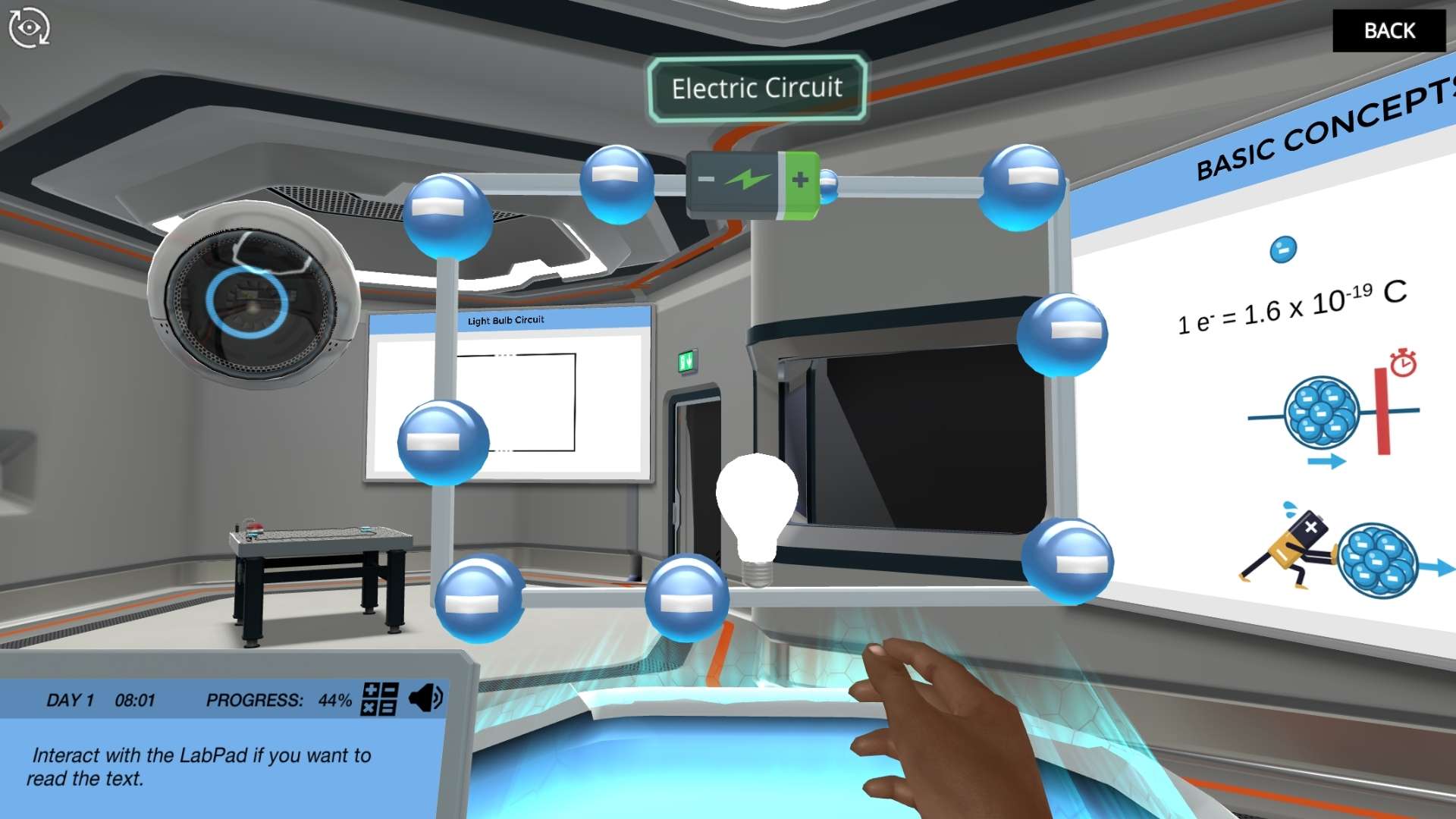Heading 1
Heading 2
Heading 3
Heading 4
Heading 5
Heading 6
Lorem ipsum dolor sit amet, consectetur adipiscing elit, sed do eiusmod tempor incididunt ut labore et dolore magna aliqua. Ut enim ad minim veniam, quis nostrud exercitation ullamco laboris nisi ut aliquip ex ea commodo consequat. Duis aute irure dolor in reprehenderit in voluptate velit esse cillum dolore eu fugiat nulla pariatur.
Block quote
Ordered list
- Item 1
- Item 2
- Item 3
Unordered list
- Item A
- Item B
- Item C
Bold text
Emphasis
Superscript
Subscript
About This Simulation
Help the scientists get electricity back in their lab by understanding how electricity works.
Learning Objectives
- Define the concepts of charge, voltage, current, and their units
- Describe the flow of current and electrons in a circuit
- Define the essential components of a basic electric circuit
- Build a functional basic electric circuit
- Apply the principles of charge and energy conservation to a basic circuit
About This Simulation
Lab Techniques
- Circuit Building
Related Standards
- HS-PS3-5
- Physics 1 Unit 8.3
- Physics 1 Unit 8.1
- Physics 1 Unit 9.1
- Physics 1 Unit 8.2
- Physics 5.1
- Physics 5.3
- 5.1 – Electric fields
Learn More About This Simulation
Electricity? We are surrounded by it! In this simulation, you will learn the very basics of electricity. What is the difference between charge, current, and voltage? How do we know what light bulb or battery do we need to use? You will find it all in this simulation, plus, you will be able to see the effects of different components in your circuit!
Get the lights back on in the lab
By understanding how electricity works, you will be able to create a circuit to restore the power supply to the lab and allow the scientists to keep working! Sometimes turning on the lights is not as easy as just pressing a switch. Help the scientists by providing a temporary solution while the lights are repaired.
Build the circuit
You will be able to build a circuit, and see how different voltages and currents will have different outcomes. What difference would it make to use a 20 volts battery or a 6 volts battery? Will a light bulb be able to work with both of them? You will discover it in this simulation.
Visualize the electricity and control it
You will be able to slow things down and see how electricity behaves, build your circuit and see the effects of adding different components. Will you be capable of bringing the lights back to the lab?
For Science Programs Providing a Learning Advantage
Boost STEM Pass Rates
Boost Learning with Fun
75% of students show high engagement and improved grades with Labster
Discover Simulations That Match Your Syllabus
Easily bolster your learning objectives with relevant, interactive content
Place Students in the Shoes of Real Scientists
Practice a lab procedure or visualize theory through narrative-driven scenarios


FAQs
Find answers to frequently asked questions.
Heading 1
Heading 2
Heading 3
Heading 4
Heading 5
Heading 6
Lorem ipsum dolor sit amet, consectetur adipiscing elit, sed do eiusmod tempor incididunt ut labore et dolore magna aliqua. Ut enim ad minim veniam, quis nostrud exercitation ullamco laboris nisi ut aliquip ex ea commodo consequat. Duis aute irure dolor in reprehenderit in voluptate velit esse cillum dolore eu fugiat nulla pariatur.
Block quote
Ordered list
- Item 1
- Item 2
- Item 3
Unordered list
- Item A
- Item B
- Item C
Bold text
Emphasis
Superscript
Subscript
A Labster virtual lab is an interactive, multimedia assignment that students access right from their computers. Many Labster virtual labs prepare students for success in college by introducing foundational knowledge using multimedia visualizations that make it easier to understand complex concepts. Other Labster virtual labs prepare learners for careers in STEM labs by giving them realistic practice on lab techniques and procedures.
Labster’s virtual lab simulations are created by scientists and designed to maximize engagement and interactivity. Unlike watching a video or reading a textbook, Labster virtual labs are interactive. To make progress, students must think critically and solve a real-world problem. We believe that learning by doing makes STEM stick.
Yes, Labster is compatible with all major LMS (Learning Management Systems) including Blackboard, Canvas, D2L, Moodle, and many others. Students can access Labster like any other assignment. If your institution does not choose an LMS integration, students will log into Labster’s Course Manager once they have an account created. Your institution will decide which is the best access method.
Labster is available for purchase by instructors, faculty, and administrators at education institutions. Purchasing our starter package, Labster Explorer, can be done using a credit card if you are located in the USA, Canada, or Mexico. If you are outside of North America or are choosing a higher plan, please speak with a Labster sales representative. Compare plans.
Labster supports a wide range of STEM courses at the high school, college, and university level across fields in biology, chemistry, physics, and health sciences. You can identify topics for your courses by searching our Content Catalog.














